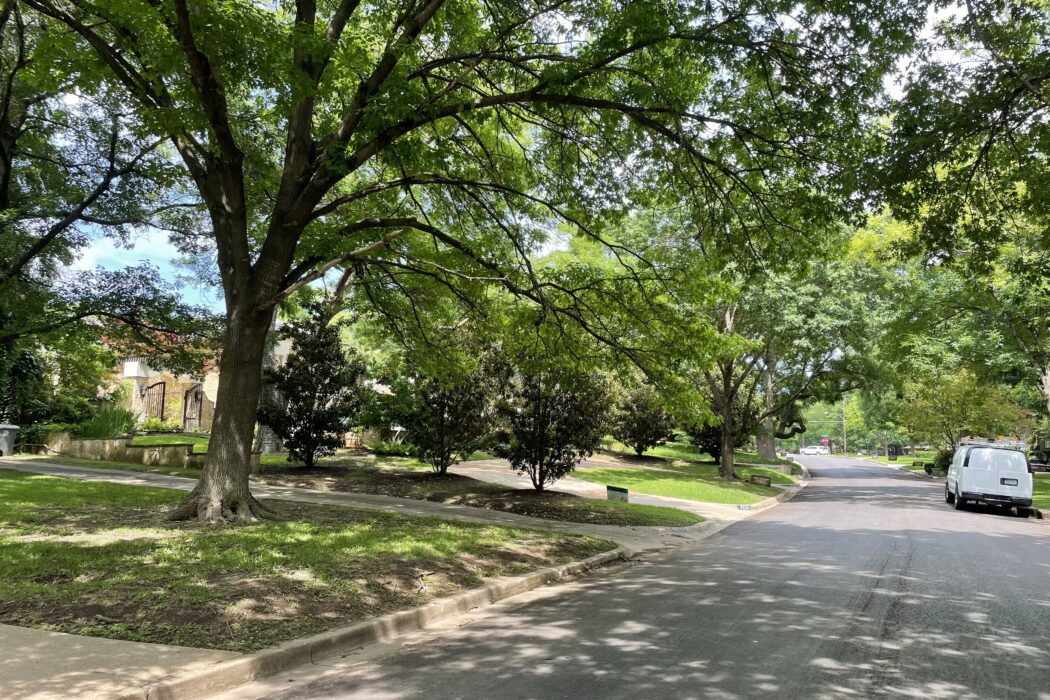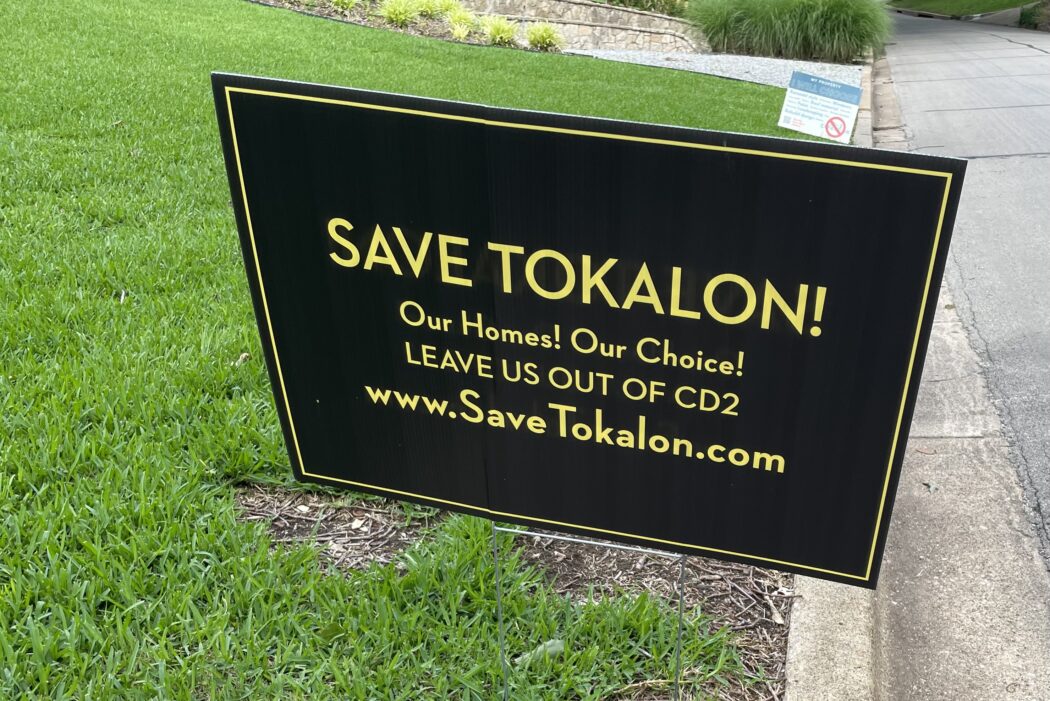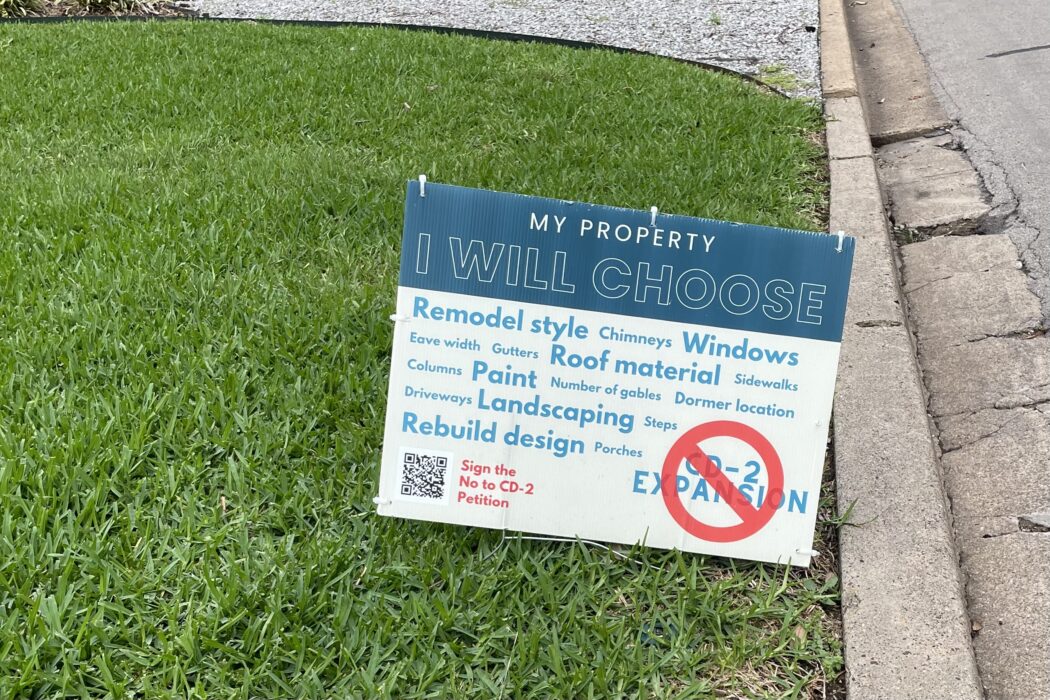
Signs opposing the Lakewood Conservation District Expansion are common in front yards along the tree-lined Tokalon Avenue. Photo by Renee Umsted.
Rob Richmond and Julie Broberg had different reactions when they were asked to consider expanding the Lakewood Conservation District.
Richmond, a former City Plan Commission member representing District 9, declined to sign a petition that would begin conversations about expanding the conservation district. He sent letters to neighbors in his and an adjacent block on Tokalon, urging them to do the same, warning of future headaches for homeowners and how the process would divide neighbors.
When fellow Tokalon resident Julie Broberg was approached, she heard that the neighborhood committee was hoping to stop demolition of historic homes and help keep new construction from being “overbuilt” by regulating setbacks and building size. These ideas appealed to her, she said, so she signed the petition.
Now, having experienced the process of expanding a conservation district, she and her husband, Brad Broberg, wish they hadn’t.
Neighborhood meetings held to discuss potential regulations ended in March, and since then, city staff have been drafting an ordinance.
No one has seen the ordinance yet, so no one can say with certainty what it will allow and prohibit.
But based on recaps presented by city staff at neighborhood meetings, Richmond and the Brobergs have some guesses about what the ordinance will likely include. And they’re not thrilled about some of the regulations.
“We’re a growing, dynamic neighborhood,” Richmond said. “We don’t need saving.”
In response, Richmond and the Brobergs are working to gather neighbors who oppose the expansion, readying to protest the ordinance at the City Plan Commission and the Dallas City Council.
They want Tokalon removed from the expansion area. The question is: Could it be?
The grievances
While Richmond and the Brobergs have been involved in different ways throughout the expansion process, they agree that it’s not fair to tell a neighbor what their house should look like — including through zoning ordinances and building codes — just because it may not match their preferences.
“The reason we have those codes, those facts, is because we want to protect the citizens from fire damage, that it’s built properly, that you’re using the right kind of building materials, all factual-based rules and regulations,” said Richmond, who has lived in a Spanish Eclectic home on Tokalon with his wife, Marian, since 1982. “Once you move into the feeling side of it, what it has to look like, what your colors are, what your paint colors are — quite frankly, it’s not American.”
In neighborhood meetings, Lakewood homeowners discussed limiting new builds in the expansion area to the five contributing styles: Spanish Eclectic, French Eclectic, Neoclassical, Colonial Revival and Tudor. All other styles would be prohibited.
Restrictions on the types of architectural styles allowed may dissuade current architects who may be renowned in the future from building in Lakewood, Julie Broberg said.
“I live in 2023, not 1923. There’s been an evolution in architecture that I think we need to respect,” Julie Broberg said. “People can build contemporary houses now. And that’s what some people want. And even though you may not like it, you still need to respect their right to do it.”
Remodels of homes may be regulated, along with new builds. The Brobergs bought their Ranch-style home over 20 years ago, drawn to its single-story layout with large rooms.
They didn’t buy their home knowing that they might one day be restricted in how they could remodel the exterior.
“You don’t have to do the ordinance,” Brad Broberg said. “We could do an association, and the people who want to volunteer their houses to an architectural control committee can do it.”

One of many signs that have appeared in front yards along Tokalon Avenue in recent weeks, leading up to the presentation of a draft ordinance for the Lakewood Conservation District Expansion. Photo by Renee Umsted.
The Brobergs and Richmond also question why the five contributing styles were selected.
In February 2022, the neighborhood committee submitted a Determination of Eligibility to the city, one of the first steps of the expansion process. In it, the neighborhood committee reported that of 275 homes in the expansion area, 206 were contributing styles. At the time, Minimal Traditional was considered contributing, but neighbors later decided in post-application meetings that it would be considered noncontributing.
With Minimal Traditional homes out, that leaves 188 homes, not 206, built in contributing styles, representing 68% of the homes in the expansion area.
But the Brobergs decided to do some fact-checking. They drove around the neighborhood to complete their own inventory of architectural styles. And they found that, based on guidelines from A Field Guide to American Houses by Virginia Savage McAlester, many of the homes initially classified under one of the contributing styles should not have been. These homes are missing key architectural features that define styles, they say.
Based on their assessment, only 47% of homes in the expansion area are contributing.
City staff have reviewed the architectural style for each of the properties in the expansion area, Trevor Brown, a chief planner for conservation districts, said in an email. Staff assigned styles to homes that were classified as “noncontributing” in the Determination of Eligibility and corrected some properties that were misidentified in the document.
An index of properties listed by address and architectural style will be included in the draft ordinance, Brown said, similar to what exists in the existing Lakewood Conservation District ordinance.
“Staff have done two windshield surveys of the expansion area and will do another ahead of presenting the draft ordinance to make sure we have everything and are comfortable with the classifications,” Brown said.
But it’s not just architectural styles that the Brobergs and Richmonds have an issue with. They say there’s an issue with earlier talk of tear downs, too.
A trend toward demolition of homes in Lakewood — 15 gone since 2011, according to a recent flyer from the neighborhood committee — was one of the points that made Julie want to sign the petition.
But the Brobergs looked at 12 properties that have been torn down over the past decade and realized the old homes would have been classified as noncontributing. It wasn’t the Hutsells or Dilbecks that were being demolished, they said.
And the homes that replaced them? The Brobergs don’t think they destroyed the neighborhood.

A sign opposing the Lakewood Conservation District expansion on Tokalon Avenue. Photo by Renee Umsted.
Next steps
The process to expand the Lakewood Conservation District is flawed and needs to start over, the Brobergs said.
They were presented with information they agreed with and signed a petition to start conversations. They disagreed with neighbors on certain topics as meetings progressed. Now, if they’re unhappy with the draft ordinance, they can voice opposition to the plan before the City Plan Commission and City Council.
“The whole process is backwards,” Brad Broberg said. “That we even have an ordinance that permits a group of 10 people to force their aesthetic on other people before they really get a chance to digest the entirety of the thing is completely backwards.”
Richmond and the Brobergs have been surveying homeowners on Tokalon to see who supports the expansion and who doesn’t.
As of publication, 34 homes on the street, or 59%, have told Richmond they are opposed to the expansion effort. Four households have voiced support for the expansion, and 18 are undecided or haven’t yet been reached.
There’s a chance that many of the homeowners on Tokalon will have their wish to be taken out of the expansion area granted.
Michael Jung, who represents District 9 on the City Plan Commission, said when the ordinance comes before the commission, he can make a motion to recommend approval of the ordinance with amendments, such as changing the territory of the expansion area.
But if Lakewood neighbors have issues with the draft ordinance when staff presents it, Jung said he would want to meet with residents and flesh out the issues.
“I want to understand what their reasons are,” Jung said. “I want to evaluate if I think their reasons are valid. If they are valid, I want to think about, talk about, OK, is there a way to address those concerns short of carving them out of the ordinance altogether, or is carving them out the best solution?”
If Jung is convinced that regulations in the ordinance are not important to preserving the character of the neighborhood or are unfairly burdensome, he said, those complaints would warrant changes. But he said he doesn’t agree with the idea that a conservation district is a philosophical infringement on a homeowner’s property rights.
Ultimately, though, Jung said he thinks it’s too early for neighbors to say they support or oppose the expansion, because they haven’t seen the draft ordinance yet; he pointed to the staff’s experience in “distilling public sentiment and balancing inconvenience and expense for homeowners against protecting the character of the conservation district.”
While there’s certainly a history of support for expanding the conservation district, Richmond and the Brobergs said in the end, based on their assumptions of what the ordinance will regulate, they don’t think people will want to support it.
“It’s just a beast compared to the [existing Lakewood Conservation District] or the relative freedom of the city code that we live under,” Julie Broberg said. “I don’t think it’s going to pass.”





